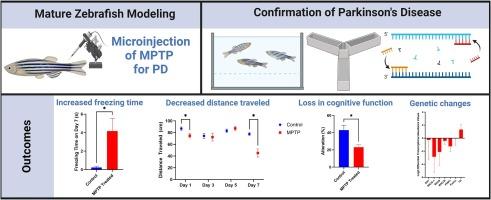将 1-甲基-4-苯基-1,2,3,6-四氢吡啶(MPTP)处理过的成年斑马鱼作为帕金森病的模型
IF 2.5
4区 医学
Q3 NEUROSCIENCES
引用次数: 0
摘要
多巴胺(DA)是一种儿茶酚胺神经递质,可调节认知功能。帕金森病(PD)患者会丧失多巴胺能神经元,神经系统分泌的多巴胺也会减少。这导致认知能力和身体机能下降,是帕金森病的特征,目前尚无治疗方法。Danio rerio(斑马鱼)已成为一种越来越流行的疾病模型,用于帕金森病的药物开发。这一模型仍需要广泛的开发,以更好地确定哪些帕金森病特征得到了充分体现。此外,绝大多数帕金森病斑马鱼模型都是在胚胎中进行的,这可能与年龄相关的人类帕金森病无关。作为一种改进,通过腹腔注射神经毒性原药 1-甲基-4-苯基-1,2,3,6-四氢吡啶(MPTP)来诱导帕金森氏症,对成熟的 D. rerio 进行了处理。行为分析证实,注射生理盐水的对照组和注射 MPTP 的实验组在运动方面存在差异,注射 MPTP 七天后,游泳距离和速度明显降低。同时,注射 MPTP 的斑马鱼的认知能力明显下降,表现为在 y 型迷宫中的交替能力下降。RT-qPCR 证实了与帕金森病遗传标记下调一致的趋势,特别是 DA 转运体 (DAT)、MAO-B 和 PINK1。总之,注射 MPTP 的成熟斑马鱼的运动和认知能力下降与人类疾病相似。尽管该模型有其优点,但它似乎并不能再现该疾病的病理生理学,也不能再现预期基因下调的全貌。因此,研究人员在寻找治疗帕金森氏症的药物干预措施时,只有在针对与人类相关的帕金森氏症症状和病因时才使用这种斑马鱼模型,这一点非常重要。本文章由计算机程序翻译,如有差异,请以英文原文为准。

1-methyl-4-phenyl-1,2,3,6-tetrahydropyridine (MPTP)-treated adult zebrafish as a model for Parkinson’s Disease
Dopamine (DA) is a catecholamine neurotransmitter that works to regulate cognitive functions. Patients affected by Parkinson’s Disease (PD) experience a loss of dopaminergic neurons and downregulated neural DA production. This leads to cognitive and physical decline that is the hallmark of PD for which no cure currently exists. Danio rerio, or zebrafish, have become an increasingly popular disease model used in PD pharmaceutical development. This model still requires extensive development to better characterize which PD features are adequately represented. Furthermore, the great majority of PD zebrafish models have been performed in embryos, which may not be relevant towards age-related human PD. As an improvement, mature D. rerio were treated with neurotoxic prodrug 1-methyl-4-phenyl-1,2,3,6-tetrahydropyridine (MPTP) through intraperitoneal injection to induce parkinsonism. Behavioral analysis confirmed disparities in movement between saline-injected control and the MPTP-injected experimental group, with swim distance and speed significantly lowered seven days after MPTP injection. Simultaneously, cognitive decline was apparent in MPTP-injected zebrafish, demonstrated by decreased alternation in a y-maze. RT-qPCR confirmed trends consistent with downregulation in Parkinsonian genetic markers, specifically DA transporter (DAT), MAO-B, PINK1. In summary, mature zebrafish injected with MPTP present with similar movement and cognitive decline as compared to human disease. Despite its benefits, this model does not appear to recapitulate pathophysiology of the disease with the full profile of expected gene downregulation. Because of this, it is important that researchers looking for pharmacological interventions for PD only use this zebrafish model when targeting the human-relevant PD symptoms and causes that are represented.
求助全文
通过发布文献求助,成功后即可免费获取论文全文。
去求助
来源期刊

Neuroscience Letters
医学-神经科学
CiteScore
5.20
自引率
0.00%
发文量
408
审稿时长
50 days
期刊介绍:
Neuroscience Letters is devoted to the rapid publication of short, high-quality papers of interest to the broad community of neuroscientists. Only papers which will make a significant addition to the literature in the field will be published. Papers in all areas of neuroscience - molecular, cellular, developmental, systems, behavioral and cognitive, as well as computational - will be considered for publication. Submission of laboratory investigations that shed light on disease mechanisms is encouraged. Special Issues, edited by Guest Editors to cover new and rapidly-moving areas, will include invited mini-reviews. Occasional mini-reviews in especially timely areas will be considered for publication, without invitation, outside of Special Issues; these un-solicited mini-reviews can be submitted without invitation but must be of very high quality. Clinical studies will also be published if they provide new information about organization or actions of the nervous system, or provide new insights into the neurobiology of disease. NSL does not publish case reports.
 求助内容:
求助内容: 应助结果提醒方式:
应助结果提醒方式:


